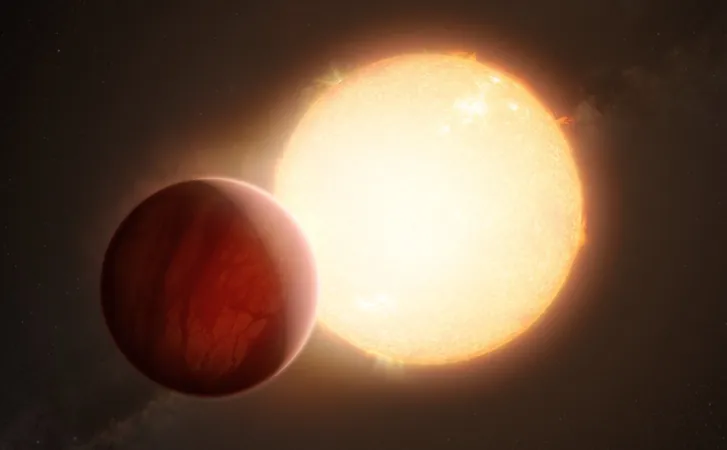
Unlocking the Secrets of Exoplanet Magnetic Fields: A Game Changer in Space Exploration!
2025-07-21
Author: Noah
The Hidden Role of Magnetic Fields in Planetary Systems
Magnetic fields are vital players in the cosmic drama of planetary systems, yet their significance is often overshadowed. Without robust magnetic shields, planets risk transforming into desolate wastelands like Mars or suffering from violent storms akin to those seen on Jupiter. Unfortunately, our insights into these magnetic forces have largely been limited to the eight planets within our solar system. But a groundbreaking preprint study from an international team of scientists could revolutionize our understanding of magnetic fields around exoplanets.
Two Paths to Discovering Exoplanet Magnetic Fields
The research highlights two key methods to investigate these elusive exoplanetary magnetic fields. The first approach is a direct detection method utilizing the Hanle and Zeeman effects. Conversely, the second relies on identifying stellar 'hot spots' within a host star's atmosphere.
Direct Detection: A Theoretical Leap Forward
For the direct detection method to be viable, observatories must capture photons traversing the exoplanet's atmosphere during its transit. Transits, as you may know, are a primary discovery method for exoplanets, providing a wealth of data to analyze. Researchers would scrutinize these photons for traces of the Hanle and Zeeman effects.
Understanding the Hanle and Zeeman Effects
The Hanle effect occurs when light interacts with a magnetic field, particularly one positioned perpendicular to the observer’s line of sight. This interaction leads to polarized light being absorbed by helium atoms in the planet’s atmosphere, creating a distinct spectrographic signature at the 'He I 1083 triplet.' Remarkably, this technique is sensitive enough to detect even weak magnetic fields, making it ideal for probing magnetic environments less intense than Earth's.
On the other hand, the Zeeman effect examines circular polarization, where light passing through a magnetic field can be affected by magnetic lines aligned with the observer’s viewpoint. This complementary approach can deepen our understanding when combined with the Hanle effect.
The Advantages and Challenges of Direct Methods
Together, these effects form a clearer picture of an exoplanet's magnetic strength and orientation. Since they rely on differential measurement, researchers can filter out potential interference from the host star's light. However, due to the need for photons to pass through the atmosphere, this method is restricted to larger planets situated near their stars.
Indirect Methods: A Different Approach
The indirect detection methods also focus on exoplanets that are in close proximity to their stars, but for different reasons. These methods investigate stellar hot spots, which arise from magnetic interactions between the star and the planet. Here, the planet's size becomes less critical, but it must be positioned within the Alfvén surface—a zone defined by potential magnetic interactions.
Interestingly, even Mercury falls outside our Sun's Alfvén surface, typically estimated at 10 to 20 solar radii. The good news? Most known exoplanets orbit their stars at such close ranges, negating this as a limitation. However, untangling whether magnetic activity stems from the planet or the stellar environment remains a challenge.
A Future of Possibilities Awaits!
Ultimately, the quest for knowledge continues. The authors of the study are optimistic that upcoming missions like the Habitable Worlds Observatory (HWO) will be pivotal in gathering the necessary data to decode these magnetic mysteries. While existing observatories can lay the groundwork for understanding strong magnetic fields, the HWO won't launch for at least another 15 years, indicating that the journey to fully grasping the magnetic fields of distant worlds is still in its infancy.
Stay Tuned for More Cosmic Discoveries!
As the field evolves, one thing is certain: unlocking the mysteries of exoplanet magnetic fields could reshape our understanding of planetary environments and their potential for hosting life beyond our solar system.









 Brasil (PT)
Brasil (PT)
 Canada (EN)
Canada (EN)
 Chile (ES)
Chile (ES)
 Česko (CS)
Česko (CS)
 대한민국 (KO)
대한민국 (KO)
 España (ES)
España (ES)
 France (FR)
France (FR)
 Hong Kong (EN)
Hong Kong (EN)
 Italia (IT)
Italia (IT)
 日本 (JA)
日本 (JA)
 Magyarország (HU)
Magyarország (HU)
 Norge (NO)
Norge (NO)
 Polska (PL)
Polska (PL)
 Schweiz (DE)
Schweiz (DE)
 Singapore (EN)
Singapore (EN)
 Sverige (SV)
Sverige (SV)
 Suomi (FI)
Suomi (FI)
 Türkiye (TR)
Türkiye (TR)
 الإمارات العربية المتحدة (AR)
الإمارات العربية المتحدة (AR)